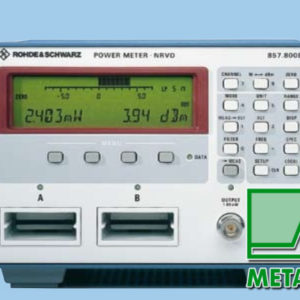Power Meter
Showing all 21 results
-
Power Meter
HP438A Dual Sensor Power Meter
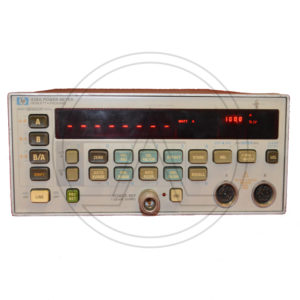
The HP 438A power meter is a dual-channel power meter designed specifically for ATE systems. The compact front panel saves critical rack space, while the dual-channel design allows simple and accurate measurements of the ratio and difference of power levels from two separate sensors. This meter is compatible with the 8480 series of power sensors.
GPIB capability is standard on the 438A. For U.S. Air Force Modular Automatic Test Equipment (MATE) system application, Option 700 provides the 438A with the internal capability to be controlled by the MATE Control Interface Intermediate Language (CIIL).
* Two power sensors for multi-port measurement
* Ratio mode for measuring gain compression
* Programmable high and low power limits for unattended power monitoring
* Frequency: 100 kHz to 26.5 GHz
* Power Range: -70 to +44 dBm
* Dynamic Range: 50 dB
* Measurement Modes: A, B, A-B, B-A, A/B, B/ASKU: 1061 -
Power Meter
ANRITSU MA2437A
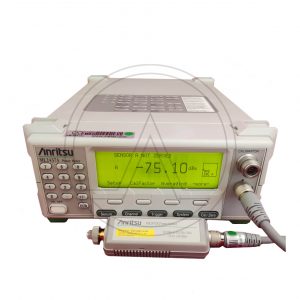
The ML2437A Power Meter combines the advantages of thermal meter accuracy, diode meter speed, and peak power meter display graphics. The result is a single instrument that samples at more than 35K per second and achieves 90 dB dynamic range with a single sensor. This meter includes graphics display capability as a standard feature. The ruggedized housing and optional high-capacity NiMH battery bring laboratory quality accuracy to field service applications. ML2437A has one input.
DatasheetSKU: n/a -
Power Meter, Power Sensor
ANRITSU ML2437A + ANRITSU MA2473A
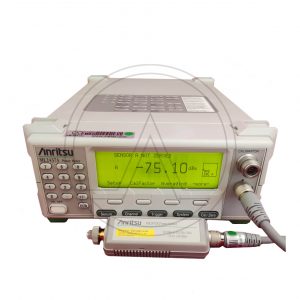
The ML2437A Power Meter combines the advantages of thermal meter accuracy, diode meter speed, and peak power meter display graphics. The result is a single instrument that samples at more than 35K per second and achieves 90 dB dynamic range with a single sensor. This meter includes graphics display capability as a standard feature. The ruggedized housing and optional high-capacity NiMH battery bring laboratory quality accuracy to field service applications. ML2437A has one input.
The MA2473A is a used 32 GHz 0.1 Watt RF Sensor from Anritsu. Electronic test equipment sensors measure the power of waveforms, such as multi-tone and modulated radiofrequency (RF) waveforms. Sensors gather highly accurate modulation measurements using diode detectors.
Additional Features:Frequency Range 10 MHz – 32 GHz
Dynamic Range -70 to +20
SWR <1.90; 10 - 50 MHz,<1.17; 50 - 150 MHz,<1.12; 0.15 - 2 GHz,<1.22; 2 - 12.4 GHz,<1.25; 12.4 - 18 GHz, <1.35; 18 - 32 GHz,<1.50; 32 - 40 GHz,<1.63; 40 - 50 GHz RF Connector Type K (m) Sensor linearity 1.8%, <18 GHz 2.5%, <40 GHz 3.5%, <50 GHz Rise time-1(ms) <0.004 DatasheetSKU: n/a -
Power Meter, Power Sensor
BOONTON 4232A + 51011-4B
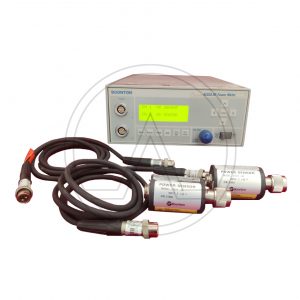
The 4230A series is compatible with every Boonton diode, thermocouple, and waveguide sensor you’re like to have, from 10 kHz to 100 GHz. Any sensor can be upgraded with a sensor data adapter to automatically download sensor information to the instrument. The 4230A series integrates smoothly with ATE systems, via its standard IEEE-488 or optional RS-232 interfaces. Available LabVIEW software drivers unleash the power of the PC for data analysis and reporting, and allow the 4230A series to integrate smoothly with other instruments into an ATE system. Emulation of HP437, 438, and 4220A is standard
The Boonton 51011 .
Boonton 51011(4B) Features:
50 Ohm Input Impedance
Type N (M) RF Connector
Frequency Range 100 kHz to 12.4 GHz
Dynamic Range -60 dBm to +20 dBm
Overload Rating 300 mW
DatasheetSKU: n/a -
Power Meter
GIGATRONICS 8541C
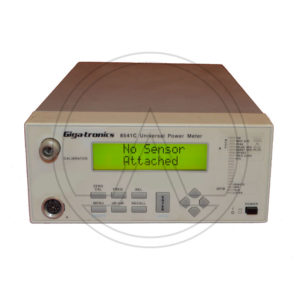
The Giga-tronics 8540C Series Universal Power Meters combine accuracy, speed, range and measurement capabilities unavailable from any other power meter. Built-in features such as power sweep calibration and frequency calibration provide an unequalled degree of measurement accuracy. Only the 8540C Series power meters have the speed and range to meet the throughput demands of high volume manufacturing. And the meters can measure the CW, peak and true average power of the complex modulated signals used in EW, radar, and communications systems.
Only the Giga-tronics 8540C Series Universal Power Meters have the extensive measurement capabilities required for today’s sophisticated communications applications.
The 8540C can automatically measure the average power of pulse modulated signals or pulse signals that are amplitude modulated during the pulse ‘on’ period — such as TDMA (time division multiple access) signals. And the exclusive burst start exclude and burst end exclude capabilities of the 8540C allow you to exclude the beginning or end of a burst when measuring the average burst power. Masking the beginning or end of a burst signal, in order to exclude overshoot or other distortions, can be desirable or even required for certain types of measurements.
The exclusive Time Gating feature of the 8540C lets you program a measurement start time and duration to measure the average power during a specific time slot of a burst signal. This is critical for accurately measuring the average power of GSM, NADC and other formats that must control the power trajectory during a specified portion of the burst.
PHS (as well as DECT and CT-2) systems use a variation of the TDMA format. Instead of using different frequency channels for the forward and reverse link, these systems use a Time Domain Duplex (TDD) method at the same frequency. The Time Gating feature of the 8540C can be used in all of the average power measurement modes to accurately measure the average power of the multiplexed time slots.
The 8540C has the speed, accuracy and range to accurately measure the power level of CDMA (code division multiple access) signals for open-loop and closed-loop testing. The wide dynamic range of the 8540C is ideal for openloop tests, which can require power verification over an 80 dB range. Because the 8540C can achieve fast measurement speeds over the GPIB bus, you can quickly measure power in1dB steps over the 48 dB range required for closed-loop tests.
And no power meter is as accurate as the 8540C over the wide dynamic range needed for CDMA testing.
Fast responding diode sensors plus innovative digital signal processing deliver highspeed measurements. Achieve 500 readings per second over GPIB. Or use our exclusive fast buffered mode to further reduce processor overhead and capture up to 4,000 readings per second in CW mode. The 8540C also responds much faster to power level changes than meters using thermocouple sensors. This adds up to a huge reduction in test time and a significant increase in manufacturing throughput.
DatasheetSKU: n/a€320.00 View Product -
Power Meter
HP-Agilent/Keysight 435B
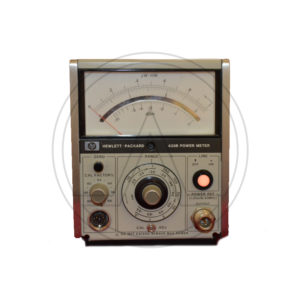
The HP 435B power meter is an analog power meter, compatible with the entire series of 8480 power sensors. Depending on which sensor is used, the 435B can measure power from -65 dBm to +44 dBm, full scale, at frequencies from 100 kHz to 110 GHz. This versatile instrument also features <1 percent instrumentation uncertainty, low noise and drift, auto-zero, recorder output, optional battery operation, and long cable options up to 61 m (200 ft). * Optional battery for fully portable operation * Accurate internal calibration source for long-term accuracy * Nine interchangeable sensors for a wide range of applications * Frequency Range: 100 kHz to 110 GHz * Power Range: -65 to +44 dBm * Instrumentation Accuracy: ±1% * Power Reference Output: 50 MHz/1MW
SKU: 23€85.00 View Product -
Power Meter
HP-Agilent/Keysight 436A
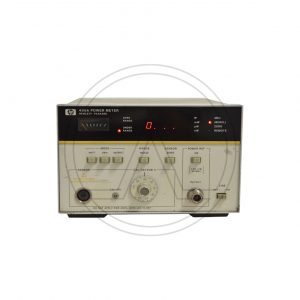
The Keysight 436A power meter is a general-purpose digital power meter intended for manual and automatic radio-frequency (RF) and microwave-power measurements. It is compatible with the entire series of 8480 power sensors. The 436A measures either absolute or relative power. It displays absolute power in either watts or dBm, and relative power in dB. The 436A offers intuitive and straightforward manual operation as well as optional GPIB programmability (Option 022).
Display readings in Watts, dBm or dB relative eliminating measurement conversion
Peaking meter for analog adjustments
Cal factor to compensate each sensor for improved accuracy
Frequency Range: 100 kHz to 110 GHz
Power Range: -70 to +44 dBm
Power Accuracy: ±0.5%
Power Reference: Internal 50 MHz oscillator/Type-N output
DatasheetSKU: 1069 -
Power Meter
HP-Agilent/Keysight 437B
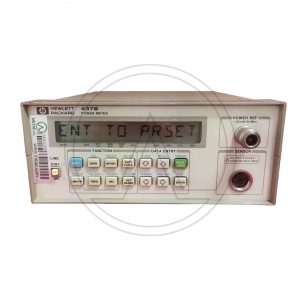
The Keysight 437B power meter is a low-cost, high-performance, single-channel, programmable, average power meter compatible with the 8480 family of power sensors. Depending on which power sensor is used, the 437B can measure from -70 dBm (100pW) to +44 dBm (25W) at frequencies from 100 kHz to 110 GHz.
Designed for the ATE systems and demanding benchtop measurements, the 437B power meter makes fast, accurate, and reliable average power measurements. Only three inches high and half rack wide, the 437B minimizes the use of critical rack space in ATE systems. The advanced plastics technology used in the 437B cabinet combines the light weight of plastic with the shielding effectiveness of metal, making the 437B the only power meter to meet MIL-STD-461C EMI specifications.
Power reference for automatic calibration and zeroing
Duty cycle entry for a convenient peak power representation of the measurement average power
Ten preloaded sensor card factors versus frequency
Frequency Range: 100 kHz to 110 GHz
DatasheetSKU: 815 -
Power Meter
HP-Agilent/Keysight N1914A
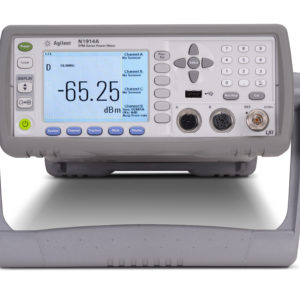
Frequency range of 9 kHz to 110 GHz (sensor dependent) Wide dynamic range of -70 to +44 dBm (sensor dependent) Speed improvement by 2X for E-Series sensors: up to 400 readings/sec Go beyond GPIB with LAN LXI-C and USB connectivity Code-compatible with E4418B, E4419B power meters Code-compatible with 436A, 437B and 438A power meters (option 200) Increased measurement channels: up to three channels with two additional U2000 Series power sensors connected using the optional USB hosts Automated frequency/power sweep measurements with the optional external trigger in/out feature
SKU: 205 -
Power Meter
HP/Agilent-Keysight E4419B
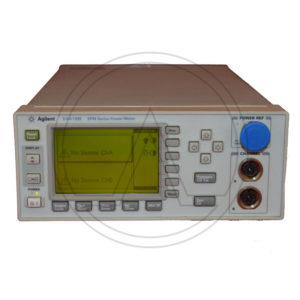
The E4419B power meter is designed for bench and automatic test equipment (ATE) use.
True dual-channel power meter – two simultaneous power readings
Fast measurement speed (up to 100 readings per second, over the GPIB, with E-series sensors)
Speed improvement of x2 using the 8480 series power sensor (compared to the 437B)
No range-switching delays with 8480 series sensors, and only one fast-range switching point with E-series sensors
Code compatibility with 438A power meter
GPIB and RS232 connector for remote control of all functionsSupplemental characteristics (shown in italics) are intended to provide additional information, useful in applying the instrument by giving typical (expected), but not warranted performance parameters. These characteristics are shown in italics or labeled as “typical”, “nominal” or “approximate”.
For information on measurement uncertainty calculations, refer to Application Note 64-1C, “Fundamentals of RF and Microwave Power Measurements”, literature number 5965-6380E.
Frequency range: 9 kHz to 110 GHz, sensor dependent
Power range: –70 dBm to +44 dBm (100 pW to 25 W), sensor dependent.
Power sensors: Compatible with all 8480 series and E-series sensors
Single sensor dynamic range: 90 dB maximum (E-series sensors), 50 dB maximum ( 8480 series sensors).
Display units: Absolute: Watts or dBm. Relative: Percent or dB.
Display resolution: Selectable resolution of 1.0, 0.1, 0.01, and 0.001 dB in Log mode, or 1 to 4 digits in linear mode.
Default resolution: 0.01 dB in log mode, 3 digits in linear mode.
DatasheetSKU: n/a -
Power Meter
ROHDE & SCHWARZ NRVS
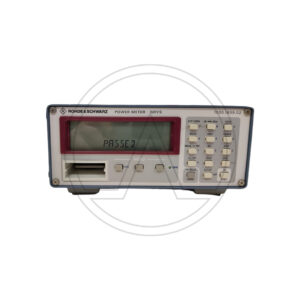
Uncompromizing technology and
ease of operation make the NRVS an
ideal instrument for any kind of power
measurement in manifold laboratory
and system applications. Thanks to its
unique measuring heads with calibra-
tion data memory and temperature
sensor, which make adjustments by
the user superfluous, the NRVS meas-
ures at all times with high accuracy
and free of operator’s errors.
The range of measuring heads includes thermal power sensors as well as highly sensitive diode power sensors, peak power
sensors, probes and insertion units for voltage measurements. The NRVS covers a power span from 100 pW up to the
kW range. In addition to the power sensors, all voltage probes of the URV5-Z series can be used.
DatasheetSKU: n/a
-
Power Meter
HP438A Dual Sensor Power Meter
The HP 438A power meter is a dual-channel power meter designed specifically for ATE systems. The compact front panel saves critical rack space, while the dual-channel design allows simple and accurate measurements of the ratio and difference of power levels from two separate sensors. This meter is compatible with the 8480 series of power sensors.
GPIB capability is standard on the 438A. For U.S. Air Force Modular Automatic Test Equipment (MATE) system application, Option 700 provides the 438A with the internal capability to be controlled by the MATE Control Interface Intermediate Language (CIIL).
* Two power sensors for multi-port measurement
* Ratio mode for measuring gain compression
* Programmable high and low power limits for unattended power monitoring
* Frequency: 100 kHz to 26.5 GHz
* Power Range: -70 to +44 dBm
* Dynamic Range: 50 dB
* Measurement Modes: A, B, A-B, B-A, A/B, B/A -
Power Meter
ANRITSU MA2437A
The ML2437A Power Meter combines the advantages of thermal meter accuracy, diode meter speed, and peak power meter display graphics. The result is a single instrument that samples at more than 35K per second and achieves 90 dB dynamic range with a single sensor. This meter includes graphics display capability as a standard feature. The ruggedized housing and optional high-capacity NiMH battery bring laboratory quality accuracy to field service applications. ML2437A has one input.
Datasheet -
Power Meter, Power Sensor
ANRITSU ML2437A + ANRITSU MA2473A
The ML2437A Power Meter combines the advantages of thermal meter accuracy, diode meter speed, and peak power meter display graphics. The result is a single instrument that samples at more than 35K per second and achieves 90 dB dynamic range with a single sensor. This meter includes graphics display capability as a standard feature. The ruggedized housing and optional high-capacity NiMH battery bring laboratory quality accuracy to field service applications. ML2437A has one input.
The MA2473A is a used 32 GHz 0.1 Watt RF Sensor from Anritsu. Electronic test equipment sensors measure the power of waveforms, such as multi-tone and modulated radiofrequency (RF) waveforms. Sensors gather highly accurate modulation measurements using diode detectors.
Additional Features:Frequency Range 10 MHz – 32 GHz
Dynamic Range -70 to +20
SWR <1.90; 10 - 50 MHz,<1.17; 50 - 150 MHz,<1.12; 0.15 - 2 GHz,<1.22; 2 - 12.4 GHz,<1.25; 12.4 - 18 GHz, <1.35; 18 - 32 GHz,<1.50; 32 - 40 GHz,<1.63; 40 - 50 GHz RF Connector Type K (m) Sensor linearity 1.8%, <18 GHz 2.5%, <40 GHz 3.5%, <50 GHz Rise time-1(ms) <0.004 Datasheet -
Power Meter, Power Sensor
BOONTON 4232A + 51011-4B
The 4230A series is compatible with every Boonton diode, thermocouple, and waveguide sensor you’re like to have, from 10 kHz to 100 GHz. Any sensor can be upgraded with a sensor data adapter to automatically download sensor information to the instrument. The 4230A series integrates smoothly with ATE systems, via its standard IEEE-488 or optional RS-232 interfaces. Available LabVIEW software drivers unleash the power of the PC for data analysis and reporting, and allow the 4230A series to integrate smoothly with other instruments into an ATE system. Emulation of HP437, 438, and 4220A is standard
The Boonton 51011 .
Boonton 51011(4B) Features:
50 Ohm Input Impedance
Type N (M) RF Connector
Frequency Range 100 kHz to 12.4 GHz
Dynamic Range -60 dBm to +20 dBm
Overload Rating 300 mW
Datasheet -
Power Meter
GIGATRONICS 8541C
The Giga-tronics 8540C Series Universal Power Meters combine accuracy, speed, range and measurement capabilities unavailable from any other power meter. Built-in features such as power sweep calibration and frequency calibration provide an unequalled degree of measurement accuracy. Only the 8540C Series power meters have the speed and range to meet the throughput demands of high volume manufacturing. And the meters can measure the CW, peak and true average power of the complex modulated signals used in EW, radar, and communications systems.
Only the Giga-tronics 8540C Series Universal Power Meters have the extensive measurement capabilities required for today’s sophisticated communications applications.
The 8540C can automatically measure the average power of pulse modulated signals or pulse signals that are amplitude modulated during the pulse ‘on’ period — such as TDMA (time division multiple access) signals. And the exclusive burst start exclude and burst end exclude capabilities of the 8540C allow you to exclude the beginning or end of a burst when measuring the average burst power. Masking the beginning or end of a burst signal, in order to exclude overshoot or other distortions, can be desirable or even required for certain types of measurements.
The exclusive Time Gating feature of the 8540C lets you program a measurement start time and duration to measure the average power during a specific time slot of a burst signal. This is critical for accurately measuring the average power of GSM, NADC and other formats that must control the power trajectory during a specified portion of the burst.
PHS (as well as DECT and CT-2) systems use a variation of the TDMA format. Instead of using different frequency channels for the forward and reverse link, these systems use a Time Domain Duplex (TDD) method at the same frequency. The Time Gating feature of the 8540C can be used in all of the average power measurement modes to accurately measure the average power of the multiplexed time slots.
The 8540C has the speed, accuracy and range to accurately measure the power level of CDMA (code division multiple access) signals for open-loop and closed-loop testing. The wide dynamic range of the 8540C is ideal for openloop tests, which can require power verification over an 80 dB range. Because the 8540C can achieve fast measurement speeds over the GPIB bus, you can quickly measure power in1dB steps over the 48 dB range required for closed-loop tests.
And no power meter is as accurate as the 8540C over the wide dynamic range needed for CDMA testing.
Fast responding diode sensors plus innovative digital signal processing deliver highspeed measurements. Achieve 500 readings per second over GPIB. Or use our exclusive fast buffered mode to further reduce processor overhead and capture up to 4,000 readings per second in CW mode. The 8540C also responds much faster to power level changes than meters using thermocouple sensors. This adds up to a huge reduction in test time and a significant increase in manufacturing throughput.
Datasheet -
Power Meter
HP-Agilent/Keysight 435B
The HP 435B power meter is an analog power meter, compatible with the entire series of 8480 power sensors. Depending on which sensor is used, the 435B can measure power from -65 dBm to +44 dBm, full scale, at frequencies from 100 kHz to 110 GHz. This versatile instrument also features <1 percent instrumentation uncertainty, low noise and drift, auto-zero, recorder output, optional battery operation, and long cable options up to 61 m (200 ft). * Optional battery for fully portable operation * Accurate internal calibration source for long-term accuracy * Nine interchangeable sensors for a wide range of applications * Frequency Range: 100 kHz to 110 GHz * Power Range: -65 to +44 dBm * Instrumentation Accuracy: ±1% * Power Reference Output: 50 MHz/1MW
-
Power Meter
HP-Agilent/Keysight 436A
The Keysight 436A power meter is a general-purpose digital power meter intended for manual and automatic radio-frequency (RF) and microwave-power measurements. It is compatible with the entire series of 8480 power sensors. The 436A measures either absolute or relative power. It displays absolute power in either watts or dBm, and relative power in dB. The 436A offers intuitive and straightforward manual operation as well as optional GPIB programmability (Option 022).
Display readings in Watts, dBm or dB relative eliminating measurement conversion
Peaking meter for analog adjustments
Cal factor to compensate each sensor for improved accuracy
Frequency Range: 100 kHz to 110 GHz
Power Range: -70 to +44 dBm
Power Accuracy: ±0.5%
Power Reference: Internal 50 MHz oscillator/Type-N output
Datasheet -
Power Meter
HP-Agilent/Keysight 437B
The Keysight 437B power meter is a low-cost, high-performance, single-channel, programmable, average power meter compatible with the 8480 family of power sensors. Depending on which power sensor is used, the 437B can measure from -70 dBm (100pW) to +44 dBm (25W) at frequencies from 100 kHz to 110 GHz.
Designed for the ATE systems and demanding benchtop measurements, the 437B power meter makes fast, accurate, and reliable average power measurements. Only three inches high and half rack wide, the 437B minimizes the use of critical rack space in ATE systems. The advanced plastics technology used in the 437B cabinet combines the light weight of plastic with the shielding effectiveness of metal, making the 437B the only power meter to meet MIL-STD-461C EMI specifications.
Power reference for automatic calibration and zeroing
Duty cycle entry for a convenient peak power representation of the measurement average power
Ten preloaded sensor card factors versus frequency
Frequency Range: 100 kHz to 110 GHz
Datasheet -
Power Meter
HP-Agilent/Keysight N1914A
Frequency range of 9 kHz to 110 GHz (sensor dependent) Wide dynamic range of -70 to +44 dBm (sensor dependent) Speed improvement by 2X for E-Series sensors: up to 400 readings/sec Go beyond GPIB with LAN LXI-C and USB connectivity Code-compatible with E4418B, E4419B power meters Code-compatible with 436A, 437B and 438A power meters (option 200) Increased measurement channels: up to three channels with two additional U2000 Series power sensors connected using the optional USB hosts Automated frequency/power sweep measurements with the optional external trigger in/out feature
-
Power Meter
HP/Agilent-Keysight E4419B
The E4419B power meter is designed for bench and automatic test equipment (ATE) use.
True dual-channel power meter – two simultaneous power readings
Fast measurement speed (up to 100 readings per second, over the GPIB, with E-series sensors)
Speed improvement of x2 using the 8480 series power sensor (compared to the 437B)
No range-switching delays with 8480 series sensors, and only one fast-range switching point with E-series sensors
Code compatibility with 438A power meter
GPIB and RS232 connector for remote control of all functionsSupplemental characteristics (shown in italics) are intended to provide additional information, useful in applying the instrument by giving typical (expected), but not warranted performance parameters. These characteristics are shown in italics or labeled as “typical”, “nominal” or “approximate”.
For information on measurement uncertainty calculations, refer to Application Note 64-1C, “Fundamentals of RF and Microwave Power Measurements”, literature number 5965-6380E.
Frequency range: 9 kHz to 110 GHz, sensor dependent
Power range: –70 dBm to +44 dBm (100 pW to 25 W), sensor dependent.
Power sensors: Compatible with all 8480 series and E-series sensors
Single sensor dynamic range: 90 dB maximum (E-series sensors), 50 dB maximum ( 8480 series sensors).
Display units: Absolute: Watts or dBm. Relative: Percent or dB.
Display resolution: Selectable resolution of 1.0, 0.1, 0.01, and 0.001 dB in Log mode, or 1 to 4 digits in linear mode.
Default resolution: 0.01 dB in log mode, 3 digits in linear mode.
Datasheet -
Power Meter
ROHDE & SCHWARZ NRVS
Uncompromizing technology and
ease of operation make the NRVS an
ideal instrument for any kind of power
measurement in manifold laboratory
and system applications. Thanks to its
unique measuring heads with calibra-
tion data memory and temperature
sensor, which make adjustments by
the user superfluous, the NRVS meas-
ures at all times with high accuracy
and free of operator’s errors.
The range of measuring heads includes thermal power sensors as well as highly sensitive diode power sensors, peak power
sensors, probes and insertion units for voltage measurements. The NRVS covers a power span from 100 pW up to the
kW range. In addition to the power sensors, all voltage probes of the URV5-Z series can be used.
Datasheet
-
Power Meter
HP438A Dual Sensor Power Meter
The HP 438A power meter is a dual-channel power meter designed specifically for ATE systems. The compact front panel saves critical rack space, while the dual-channel design allows simple and accurate measurements of the ratio and difference of power levels from two separate sensors. This meter is compatible with the 8480 series of power sensors.
GPIB capability is standard on the 438A. For U.S. Air Force Modular Automatic Test Equipment (MATE) system application, Option 700 provides the 438A with the internal capability to be controlled by the MATE Control Interface Intermediate Language (CIIL).
* Two power sensors for multi-port measurement
* Ratio mode for measuring gain compression
* Programmable high and low power limits for unattended power monitoring
* Frequency: 100 kHz to 26.5 GHz
* Power Range: -70 to +44 dBm
* Dynamic Range: 50 dB
* Measurement Modes: A, B, A-B, B-A, A/B, B/A -
Power Meter
ANRITSU MA2437A
The ML2437A Power Meter combines the advantages of thermal meter accuracy, diode meter speed, and peak power meter display graphics. The result is a single instrument that samples at more than 35K per second and achieves 90 dB dynamic range with a single sensor. This meter includes graphics display capability as a standard feature. The ruggedized housing and optional high-capacity NiMH battery bring laboratory quality accuracy to field service applications. ML2437A has one input.
Datasheet -
Power Meter, Power Sensor
ANRITSU ML2437A + ANRITSU MA2473A
The ML2437A Power Meter combines the advantages of thermal meter accuracy, diode meter speed, and peak power meter display graphics. The result is a single instrument that samples at more than 35K per second and achieves 90 dB dynamic range with a single sensor. This meter includes graphics display capability as a standard feature. The ruggedized housing and optional high-capacity NiMH battery bring laboratory quality accuracy to field service applications. ML2437A has one input.
The MA2473A is a used 32 GHz 0.1 Watt RF Sensor from Anritsu. Electronic test equipment sensors measure the power of waveforms, such as multi-tone and modulated radiofrequency (RF) waveforms. Sensors gather highly accurate modulation measurements using diode detectors.
Additional Features:Frequency Range 10 MHz – 32 GHz
Dynamic Range -70 to +20
SWR <1.90; 10 - 50 MHz,<1.17; 50 - 150 MHz,<1.12; 0.15 - 2 GHz,<1.22; 2 - 12.4 GHz,<1.25; 12.4 - 18 GHz, <1.35; 18 - 32 GHz,<1.50; 32 - 40 GHz,<1.63; 40 - 50 GHz RF Connector Type K (m) Sensor linearity 1.8%, <18 GHz 2.5%, <40 GHz 3.5%, <50 GHz Rise time-1(ms) <0.004 Datasheet -
Power Meter, Power Sensor
BOONTON 4232A + 51011-4B
The 4230A series is compatible with every Boonton diode, thermocouple, and waveguide sensor you’re like to have, from 10 kHz to 100 GHz. Any sensor can be upgraded with a sensor data adapter to automatically download sensor information to the instrument. The 4230A series integrates smoothly with ATE systems, via its standard IEEE-488 or optional RS-232 interfaces. Available LabVIEW software drivers unleash the power of the PC for data analysis and reporting, and allow the 4230A series to integrate smoothly with other instruments into an ATE system. Emulation of HP437, 438, and 4220A is standard
The Boonton 51011 .
Boonton 51011(4B) Features:
50 Ohm Input Impedance
Type N (M) RF Connector
Frequency Range 100 kHz to 12.4 GHz
Dynamic Range -60 dBm to +20 dBm
Overload Rating 300 mW
Datasheet -
Power Meter
GIGATRONICS 8541C
The Giga-tronics 8540C Series Universal Power Meters combine accuracy, speed, range and measurement capabilities unavailable from any other power meter. Built-in features such as power sweep calibration and frequency calibration provide an unequalled degree of measurement accuracy. Only the 8540C Series power meters have the speed and range to meet the throughput demands of high volume manufacturing. And the meters can measure the CW, peak and true average power of the complex modulated signals used in EW, radar, and communications systems.
Only the Giga-tronics 8540C Series Universal Power Meters have the extensive measurement capabilities required for today’s sophisticated communications applications.
The 8540C can automatically measure the average power of pulse modulated signals or pulse signals that are amplitude modulated during the pulse ‘on’ period — such as TDMA (time division multiple access) signals. And the exclusive burst start exclude and burst end exclude capabilities of the 8540C allow you to exclude the beginning or end of a burst when measuring the average burst power. Masking the beginning or end of a burst signal, in order to exclude overshoot or other distortions, can be desirable or even required for certain types of measurements.
The exclusive Time Gating feature of the 8540C lets you program a measurement start time and duration to measure the average power during a specific time slot of a burst signal. This is critical for accurately measuring the average power of GSM, NADC and other formats that must control the power trajectory during a specified portion of the burst.
PHS (as well as DECT and CT-2) systems use a variation of the TDMA format. Instead of using different frequency channels for the forward and reverse link, these systems use a Time Domain Duplex (TDD) method at the same frequency. The Time Gating feature of the 8540C can be used in all of the average power measurement modes to accurately measure the average power of the multiplexed time slots.
The 8540C has the speed, accuracy and range to accurately measure the power level of CDMA (code division multiple access) signals for open-loop and closed-loop testing. The wide dynamic range of the 8540C is ideal for openloop tests, which can require power verification over an 80 dB range. Because the 8540C can achieve fast measurement speeds over the GPIB bus, you can quickly measure power in1dB steps over the 48 dB range required for closed-loop tests.
And no power meter is as accurate as the 8540C over the wide dynamic range needed for CDMA testing.
Fast responding diode sensors plus innovative digital signal processing deliver highspeed measurements. Achieve 500 readings per second over GPIB. Or use our exclusive fast buffered mode to further reduce processor overhead and capture up to 4,000 readings per second in CW mode. The 8540C also responds much faster to power level changes than meters using thermocouple sensors. This adds up to a huge reduction in test time and a significant increase in manufacturing throughput.
Datasheet€320.00 View Product -
Power Meter
HP-Agilent/Keysight 435B
The HP 435B power meter is an analog power meter, compatible with the entire series of 8480 power sensors. Depending on which sensor is used, the 435B can measure power from -65 dBm to +44 dBm, full scale, at frequencies from 100 kHz to 110 GHz. This versatile instrument also features <1 percent instrumentation uncertainty, low noise and drift, auto-zero, recorder output, optional battery operation, and long cable options up to 61 m (200 ft). * Optional battery for fully portable operation * Accurate internal calibration source for long-term accuracy * Nine interchangeable sensors for a wide range of applications * Frequency Range: 100 kHz to 110 GHz * Power Range: -65 to +44 dBm * Instrumentation Accuracy: ±1% * Power Reference Output: 50 MHz/1MW
€85.00 View Product -
Power Meter
HP-Agilent/Keysight 436A
The Keysight 436A power meter is a general-purpose digital power meter intended for manual and automatic radio-frequency (RF) and microwave-power measurements. It is compatible with the entire series of 8480 power sensors. The 436A measures either absolute or relative power. It displays absolute power in either watts or dBm, and relative power in dB. The 436A offers intuitive and straightforward manual operation as well as optional GPIB programmability (Option 022).
Display readings in Watts, dBm or dB relative eliminating measurement conversion
Peaking meter for analog adjustments
Cal factor to compensate each sensor for improved accuracy
Frequency Range: 100 kHz to 110 GHz
Power Range: -70 to +44 dBm
Power Accuracy: ±0.5%
Power Reference: Internal 50 MHz oscillator/Type-N output
Datasheet -
Power Meter
HP-Agilent/Keysight 437B
The Keysight 437B power meter is a low-cost, high-performance, single-channel, programmable, average power meter compatible with the 8480 family of power sensors. Depending on which power sensor is used, the 437B can measure from -70 dBm (100pW) to +44 dBm (25W) at frequencies from 100 kHz to 110 GHz.
Designed for the ATE systems and demanding benchtop measurements, the 437B power meter makes fast, accurate, and reliable average power measurements. Only three inches high and half rack wide, the 437B minimizes the use of critical rack space in ATE systems. The advanced plastics technology used in the 437B cabinet combines the light weight of plastic with the shielding effectiveness of metal, making the 437B the only power meter to meet MIL-STD-461C EMI specifications.
Power reference for automatic calibration and zeroing
Duty cycle entry for a convenient peak power representation of the measurement average power
Ten preloaded sensor card factors versus frequency
Frequency Range: 100 kHz to 110 GHz
Datasheet -
Power Meter
HP-Agilent/Keysight N1914A
Frequency range of 9 kHz to 110 GHz (sensor dependent) Wide dynamic range of -70 to +44 dBm (sensor dependent) Speed improvement by 2X for E-Series sensors: up to 400 readings/sec Go beyond GPIB with LAN LXI-C and USB connectivity Code-compatible with E4418B, E4419B power meters Code-compatible with 436A, 437B and 438A power meters (option 200) Increased measurement channels: up to three channels with two additional U2000 Series power sensors connected using the optional USB hosts Automated frequency/power sweep measurements with the optional external trigger in/out feature
-
Power Meter
HP/Agilent-Keysight E4419B
The E4419B power meter is designed for bench and automatic test equipment (ATE) use.
True dual-channel power meter – two simultaneous power readings
Fast measurement speed (up to 100 readings per second, over the GPIB, with E-series sensors)
Speed improvement of x2 using the 8480 series power sensor (compared to the 437B)
No range-switching delays with 8480 series sensors, and only one fast-range switching point with E-series sensors
Code compatibility with 438A power meter
GPIB and RS232 connector for remote control of all functionsSupplemental characteristics (shown in italics) are intended to provide additional information, useful in applying the instrument by giving typical (expected), but not warranted performance parameters. These characteristics are shown in italics or labeled as “typical”, “nominal” or “approximate”.
For information on measurement uncertainty calculations, refer to Application Note 64-1C, “Fundamentals of RF and Microwave Power Measurements”, literature number 5965-6380E.
Frequency range: 9 kHz to 110 GHz, sensor dependent
Power range: –70 dBm to +44 dBm (100 pW to 25 W), sensor dependent.
Power sensors: Compatible with all 8480 series and E-series sensors
Single sensor dynamic range: 90 dB maximum (E-series sensors), 50 dB maximum ( 8480 series sensors).
Display units: Absolute: Watts or dBm. Relative: Percent or dB.
Display resolution: Selectable resolution of 1.0, 0.1, 0.01, and 0.001 dB in Log mode, or 1 to 4 digits in linear mode.
Default resolution: 0.01 dB in log mode, 3 digits in linear mode.
Datasheet -
Power Meter
ROHDE & SCHWARZ NRVS
Uncompromizing technology and
ease of operation make the NRVS an
ideal instrument for any kind of power
measurement in manifold laboratory
and system applications. Thanks to its
unique measuring heads with calibra-
tion data memory and temperature
sensor, which make adjustments by
the user superfluous, the NRVS meas-
ures at all times with high accuracy
and free of operator’s errors.
The range of measuring heads includes thermal power sensors as well as highly sensitive diode power sensors, peak power
sensors, probes and insertion units for voltage measurements. The NRVS covers a power span from 100 pW up to the
kW range. In addition to the power sensors, all voltage probes of the URV5-Z series can be used.
Datasheet
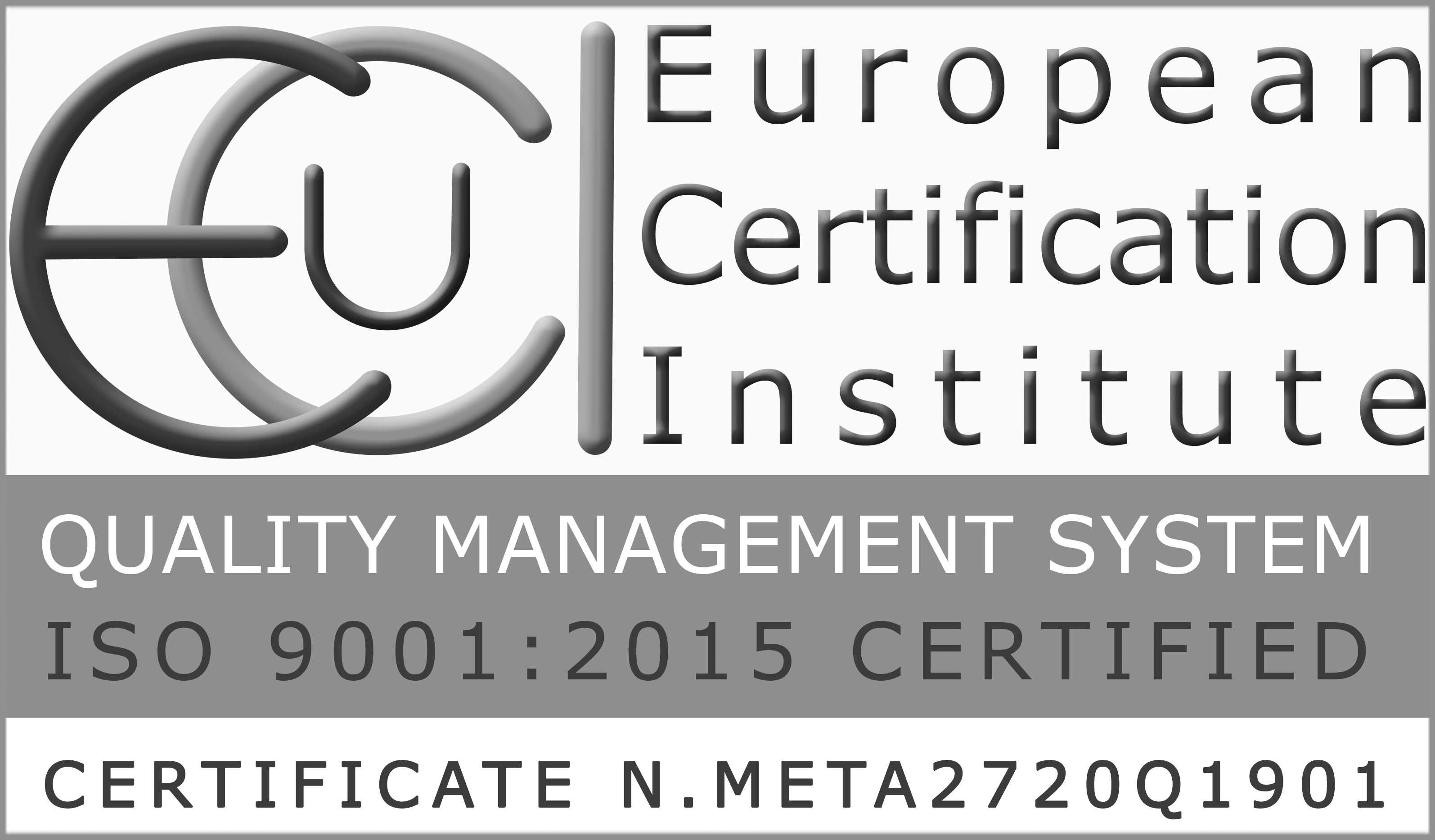


 Italiano
Italiano


















